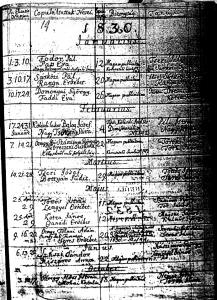This register is from the Reformed Church in the town of Szekszárd in Tolna county. It is very neatly done in a hand-drawn tablular format. The marriages are ordered by date (ie. the third column) while the first column contains the dates of the announcement of banns (betrothal). It was traditional to announce the betrothal to the congregation for three consecutive weeks, to allow opportunity for anyone to raise objections to the proposed marriage. This process was especially important in the Reformed church, and the dates of the announcements were often documented in Reformed church registers.
Format: Hand-drawn tabular format, ordered by date of marriage (col 3).





Content of Register.
This register contains many family names beginning with the old form Ts which by this time was largely replace by Cs in most of Hungarian records. Again we have a register which provides minimal information about the couple themselves. The May 20 wedding is the second marriage of my fourth-great-grandfather.
Column.
- Dates of Banns Announcement: note that no month is specified if the banns were all announced (ie "published") in the month of marriage; otherwise the month is given. Three announcements was the norm.
- Names of Persons being Married: In this register, in general only the names of the couple are provided. Additional notes indicate widows and widowers (özvegy). Widowers are only thus identified (see Feb 22, May 20, Oct 18 grooms). Widows are identified with both their late husband and their maiden name (see May 20 bride). Most of the people in the register are local, so their parents are well-known to the members of the congregation. Persons from other towns are identified as such. Remember that most marriages took place in the home church of the bride. Therefore, grooms are more likely to be from other towns (see Feb 4 groom from Kölesd). But, on this page we find two brides employed as servants in nearby towns (but probably originating in Szekszárd) and this is noted (see Jan 12 and Feb 22 brides working respectively in Nagydorog and Kölesd).
- Date of Marriage: The register is ordered by this third column of information.
- Evidence (concerning Banns) Provided: In most cases, the pastor wrote Magam publicátam meaning announced by myself. Note that in the cases of women working in other towns a letter requesting information about them is identified. The Feb 4 entry identifies the pastor in Kölesd who presumably also announced the betrothal in his church. In the case of my ancestor (the May 20 entry) there is a more detailed entry. It states: getting out from under the obstacle of their relationship by marriage was aided by a dispensation from His Majesty on 22nd of January 1830; number 144 -- the fact was that the bride was the niece of the groom's late wife, apparently requiring a royal dispensation.
- Witnesses: The Magyar word Tanük meaning witnesses is used here. Generally two men, often a senior relative of the bride and groom, served as witnesses. In the case of my ancestor these were a cousin of the groom and the brother of the bride (who was a prominent city judge); keep in mind that this was a second and third marriage of an older couple, so it is unlikely that uncles (the more typical witnesses to the marriage of a young couple) were able to serve.